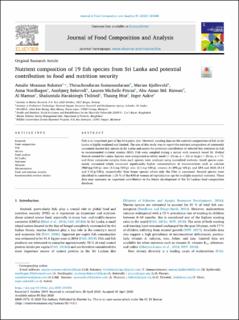| dc.contributor.author | Reksten, Amalie Moxness | |
| dc.contributor.author | Somasundaram, Thiruchenduran | |
| dc.contributor.author | Kjellevold, Marian | |
| dc.contributor.author | Nordhagen, Anna | |
| dc.contributor.author | Bøkevoll, Annbjørg | |
| dc.contributor.author | Pincus, Lauren | |
| dc.contributor.author | Md. Rizwan, Abu Ansar | |
| dc.contributor.author | Mamun, Al | |
| dc.contributor.author | Thilsted, Shakuntala Haraksing | |
| dc.contributor.author | Htut, Thaung | |
| dc.contributor.author | Aakre, Inger | |
| dc.date.accessioned | 2020-10-22T12:58:01Z | |
| dc.date.available | 2020-10-22T12:58:01Z | |
| dc.date.created | 2020-08-11T12:20:54Z | |
| dc.date.issued | 2020 | |
| dc.identifier.citation | Journal of Food Composition and Analysis. 2020, 91 . | en_US |
| dc.identifier.issn | 0889-1575 | |
| dc.identifier.uri | https://hdl.handle.net/11250/2684559 | |
| dc.description.abstract | Fish is an important part of the Sri Lankan diet. However, existing data on the nutrient composition of fish in Sri Lanka is highly outdated and limited. The aim of this study was to report the nutrient composition of commonly consumed marine fish species in Sri Lanka and assess the potential contribution of selected key nutrients in fish to recommended nutrient intakes (RNI). Fish were sampled during a survey with research vessel Dr. Fridtjof Nansen around Sri Lanka. Species were categorised as either small (<25 cm, n = 12) or large (>25 cm, n = 7), and three composite samples from each species were analysed using accredited methods. Small species commonly consumed whole contained significantly higher concentrations of micronutrients such as calcium (960 mg/100 g), iron (3.3 mg/100 g), zinc (2.1 mg/100 g), vitamin A (295 μg/100 g), and EPA and DHA (0.14 and 0.32 g/100 g, respectively) than larger species where only the fillet is consumed. Several species were identified to contribute ≥25 % of the RNI of women of reproductive age for multiple essential nutrients. These data may represent an important contribution to the future development of the Sri Lankan food composition database. | en_US |
| dc.language.iso | eng | en_US |
| dc.title | Nutrient composition of 19 fish species from Sri Lanka and potential contribution to food and nutrition security | en_US |
| dc.type | Peer reviewed | en_US |
| dc.type | Journal article | en_US |
| dc.description.version | publishedVersion | en_US |
| dc.source.pagenumber | 103508 | en_US |
| dc.source.volume | 91 | en_US |
| dc.source.journal | Journal of Food Composition and Analysis | en_US |
| dc.identifier.doi | https://doi.org/10.1016/j.jfca.2020.103508 | |
| dc.identifier.cristin | 1822723 | |
| cristin.ispublished | true | |
| cristin.fulltext | original | |
| cristin.qualitycode | 1 | |
